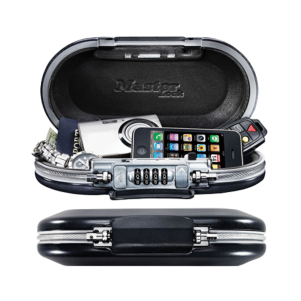Understanding lock types on portable safes
Portable safes are extremely useful for people on the move. We often use portable safes for ensuring our valuables, or amounts of cash and important documents, are safe while we are out of the house, or away from home for a period of time. Portable safes are usually much smaller than standard safes which we might install as an integral feature of cupboards, or in hidden places such as a wall or floor access, or a safe we might bolt to a wall or floor. However, the size and mobile nature of a portable safe are not the only considerations we need to make when choosing the right portable safe. We also need to think about the locking mechanism and which is most suitable to our needs.
What locking mechanisms are available for portable safes?
The physical security of a lock on a portable safe is pretty much the same, whichever style of lock you go for. So there is the same level of peace of mind regardless. The main consideration is what level of simplicity and convenience we want. Here we have listed the four main types of locking system widely available for portable safes and have studied the pros and cons of each type.
Keys have been used to lock and unlock safes for centuries, and the internal systems have evolved to become more sophisticated and security proof. However, the simple facts remain that you need to physically interact with the safe to open it with a key. This system is traditional, simple and reliable, and doesn’t require any form of electrical power in order to operate it. On the flipside, it is possible to lose a key, or for it to be stolen, and it is also possible to copy a key. So there are security risks with a key system. With constant and repetitive use, there are also occasions where a key could wear, or the internal mechanism sticks and no longer works. So key systems can require some maintenance. Another downside to key systems is they can be cumbersome and awkward if you need access to the safe several times a day.
This is probably the first system that started to rival the traditional key. It is a system of usually four dials, with numbers on. The user needs to align the numbers in a specific sequence, and therefore, the internal gears are also aligned, in order to open the safe. This provides a good level of security, although there is nothing to stop someone telling another person what the code is. However, there is no power needed and the system is reliable for repeated use. The downside of the combination dial system is that you have to remember the code and it is not easy to reset. It can also be time-consuming to line the numbers up, and over time, if you have an older safe the dials can stick and the lock can become difficult to use because you need to very carefully line the numbers up. Therefore, the combination dial can become frustrating to use if you need regular access and in a hurry.
An electronic keypad is a more modern version of the combination dial, and is perhaps the most common type of lock seen today. This requires the user to insert a unique PIN code using numerical pushbuttons. This type of system is fast and convenient and is easy to use. It requires the user to remember the code, but the system can be reset quite easily to set up a new code. With more sophisticated systems you can also set-up a different code for individual users. So this is an ideal system for people in a hurry and who need to access the safe frequently. However, this type of system does require a power source, usually an internal battery. So the system could fail and you would need a back-up, such as a traditional key. Like anything digital and electrical, this type of system can also be hacked potentially, although more modern systems are much harder to bypass in this way. So electronic keypads offer a good level of security and practicality.
This type of locking system is the most contemporary and possibly the most secure. Essentially, the system is operated using sensors which recognise a unique biometric feature when it is presented by the user. So this could be facial recognition, fingerprint recognition or even a retina scan. This offers a high level of security as the features cannot be copied, stolen or bypassed. This system is also very fast and reliable as the lock can be disengaged in a second, so this is perhaps the most convenient of the systems we have presented here. Because this is a digital system, this type of locking mechanism requires a power source, so the user has to also think about a back-up system. However, the power source is easy to manage and you should be able to avoid any power loss and hence any security issues.
So check out the range of portable safes supplied by MB Direct and choose the locking mechanism most suitable to you. If you balance simplicity and reliability with security and complexity, you should be able to find the right locking system solution.